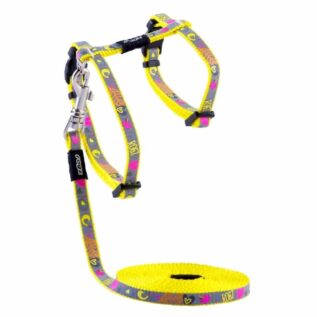How to Choose a Cat Collar or Harness for Your Cat
Introduction
Choosing the right cat collar or harness for your furry friend is essential to ensure their safety and comfort. There are various types of collars and harnesses available, and picking the right one can be quite confusing. In this article, we will discuss different types of collars and harnesses, how to measure your cat, material considerations, additional features, and tips on training your cat to use them. Let's get started!
Types of Cat Collars
Breakaway Collars
Breakaway collars are designed to release when pressure is applied, allowing your cat to free themselves if they get caught on something. This type of collar is ideal for outdoor cats, as it can prevent them from getting trapped or injured.
Non-Breakaway Collars
Non-breakaway collars do not release under pressure, making them more suitable for indoor cats. However, they might pose a risk if your cat manages to get outside and becomes stuck on an obstacle.
Types of Cat Harnesses
H-Style Harnesses
H-style harnesses have straps that form an "H" shape when viewed from above. These harnesses evenly distribute pressure on your cat's body and provide more control than a collar.
Figure-8 Harnesses
Figure-8 harnesses consist of a single strap that wraps around your cat's body in the shape of an "8." They are adjustable and less restrictive than other types of harnesses, making them a good choice for cats that are not used to wearing one.
Vest Harnesses
Vest harnesses cover a larger portion of your cat's body and provide maximum comfort and support. They are ideal for cats with sensitive skin or those prone to slipping out of other types of harnesses.
How to Measure Your Cat
Before purchasing a collar or harness, it's essential to measure your cat accurately to ensure a proper fit. Use a soft measuring tape to measure your cat's neck circumference for a collar and the girth around their chest for a harness. Add an inch or two for comfort and adjustability.
Material Considerations
Leather
Leather collars and harnesses are durable and stylish, but they can be expensive and require regular maintenance to keep them in good condition.
Nylon
Nylon is a popular choice for collars and harnesses due to its affordability, durability, and ease of cleaning. However, it can be less comfortable for cats with sensitive skin.
Eco-Friendly Materials
Eco-friendly materials, such as hemp or recycled materials, are a sustainable option for cat collars and harnesses. They are typically soft and comfortable for your cat while being gentle on the environment.
Additional Features
Reflective or Glow-in-the-Dark
Reflective or glow-in-the-dark collars and harnesses can help keep your cat visible at night, improving their safety when outdoors.
Bells and ID Tags
Bells can be useful for alerting you and wildlife to your cat's presence, while ID tags can provide essential contact information in case your cat gets lost.
Training Your Cat
Introduce your cat to their new collar or harness gradually, allowing them time to get used to the sensation. Reward them with treats and praise to make the experience positive. Start with short sessions indoors before venturing outside.
How tight should a cat collar be?
A cat collar should be snug but not too tight. You should be able to fit two fingers between the collar and your cat's neck.
Can I use a dog collar or harness for my cat?
Dog collars and harnesses are not designed for cats and may not provide the necessary safety features or adjustability. It's best to choose a collar or harness specifically designed for cats.
How do I get my cat used to wearing a collar or harness?
Introduce your cat to its new collar or harness gradually, using treats and praise to create a positive association. Start with short sessions indoors before venturing outside.
Should indoor cats wear collars or harnesses?
Indoor cats can benefit from wearing a collar with an ID tag in case they accidentally escape. Harnesses can be useful for taking your indoor cat on supervised outdoor excursions.
How often should I replace my cat's collar or harness?
Inspect your cat's collar or harness regularly for signs of wear or damage. Replace them as needed to ensure your cat's safety and comfort.






















